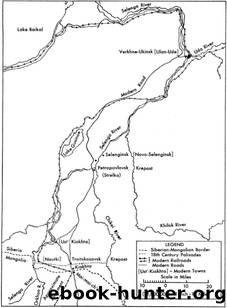Muscovite and Mandarin by Clifford M. Foust

Author:Clifford M. Foust [Foust, Clifford M.]
Language: eng
Format: epub
Tags: History, Russia & the Former Soviet Union, Asia, China
ISBN: 9780807873649
Google: jQZfDwAAQBAJ
Publisher: UNC Press Books
Published: 2018-06-15T00:41:52+00:00
Catherineâs Conference
Russian military preparations were pushed swiftly ahead in 1764 for what began to look like eventual war with the Chinese. In late spring the Senate listened to reports, once again, of the inadequacy of the forces on the Mongolian border; Iakobi had in his command about twenty-five hundred men in two regiments, one cavalry and one infantry, both understaffed and undersupplied, and an insufficient number of Cossacks.79 The Senate gave him permission to enroll twenty-four hundred of the local Buriats into paramilitary units.80 These irregulars were expected to provide their own maintenance in lieu of paying iasak, and Iakobi was instructed to keep close watch on them so that they did not defect to the Mongol side, since after all they were close kin to the Khalkas. To compensate for the loss of customs revenues which had formerly been used, in part, to pay the salaries of the Iakutsk infantry and cavalry regiments, the Senate also ordered funds to be released from the Kolyvanovoskresensk mines funds. Already ordered in an imperial ukaz of 29 November 1763, the prohibition against the bulk sale and purchase of grain in Irkutsk and Eniseisk was repeated at this time. Artillery and shells were reported in especially short supply in Selenginsk; the new Siberian Governor Chicherin asked for nineteen three-pounders and a bomb mortar.
In October of 1764 Catherine summoned a full conference of seven leading civil and military officials to review the deterioration of trade relations with China and to suggest military measures appropriate to the aggravated situation.81 The conference provided the Empress with a full description of affairs as best they were known and offered recommendations for the defense of the realm in the event of war and for the improvement of the administration of commerce should conflict be avoided. Neither eventuality was slighted.
Reinforcements should be added along most of the frontier, bringing the total strength of Siberian military forces to eleven regiments.82 Units should be augmented at Petropavlovsk on the Ishim; Omsk, Iamyshev, and Ustâ-Kamenogorsk on the Irtysh; Zhelenzensk; Biisk on the Obâ; Kuznetsk on the Tomâ; and at Irkutsk and Selenginsk, i.e., across the whole sweep of southern Siberia at all the critical towns. Two dragoon regiments should be transferred from Kazanâ to key reserve locations, the Azov regiment to Petropavlovsk and the Revelâ to Omsk. Additional artillery must be dispatched to Omsk and Selenginsk, but the majority of regiments must be held in reserve rather than committing them to inaccessible outposts. Since much of the border was mountainous or otherwise impassable, the rapid transfer of units from one point to another was impossible; this was a sensible defensive posture.
In Transbaikalia minor efforts were to be made. Kudarinsk suburb on the Chikoi River was scheduled for strengthening with ditches, palisades, and earthen redoubts, and one thousand rubles were allocated for an arsenal at Kiakhta to provide all inhabitants with weapons. Two companies of the Selenginsk garrison were detached to improve the fortifications of the Cossack-manned Akchinsk fort between Kiakhta and Nerchinsk on the Onon River.
Download
This site does not store any files on its server. We only index and link to content provided by other sites. Please contact the content providers to delete copyright contents if any and email us, we'll remove relevant links or contents immediately.
| Africa | Americas |
| Arctic & Antarctica | Asia |
| Australia & Oceania | Europe |
| Middle East | Russia |
| United States | World |
| Ancient Civilizations | Military |
| Historical Study & Educational Resources |
Machine Learning at Scale with H2O by Gregory Keys | David Whiting(4172)
Never by Ken Follett(3788)
Fairy Tale by Stephen King(3216)
The Man Who Died Twice by Richard Osman(2995)
Oathbringer (The Stormlight Archive, Book 3) by Brandon Sanderson(2871)
Will by Will Smith(2790)
Rationality by Steven Pinker(2290)
The Dark Hours by Michael Connelly(2243)
Can't Hurt Me: Master Your Mind and Defy the Odds - Clean Edition by David Goggins(2225)
The Dawn of Everything: A New History of Humanity by David Graeber & David Wengrow(2122)
Friends, Lovers, and the Big Terrible Thing by Matthew Perry(2117)
Principles for Dealing With the Changing World Order: Why Nations Succeed and Fail by Ray Dalio(1969)
HBR's 10 Must Reads 2022 by Harvard Business Review(1776)
A Short History of War by Jeremy Black(1758)
Go Tell the Bees That I Am Gone by Diana Gabaldon(1685)
515945210 by Unknown(1599)
A Game of Thrones (The Illustrated Edition) by George R. R. Martin(1587)
Kingdom of Ash by Maas Sarah J(1521)
443319537 by Unknown(1466)
